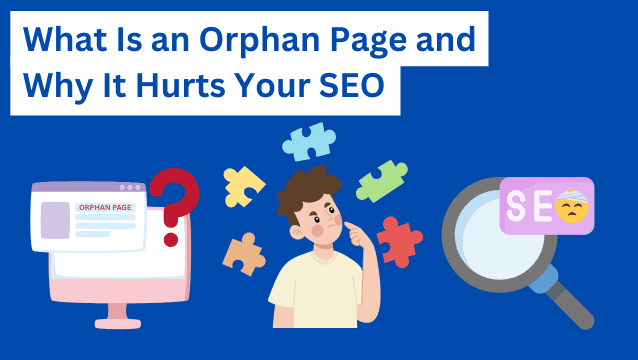B2B SEO has never been more challenging. From the rapid adoption of generative AI tools to constant search algorithm updates, the landscape is evolving really fast.
Add Google and Bing leveraging proprietary data for tools like AI Overviews and Co-Pilot, and it’s clear why businesses are feeling the pressure.
But that’s not all. Budget cuts, shifting audience content consumption habits, and leadership buy-in struggles have compounded the uncertainty.
As someone who works closely with the B2B audience, I’ve been hearing one question more than ever: What’s next for B2B SEO?
To answer this, I teamed up with uSERP, a trusted SEO and link-building agency, to uncover the emerging trends and technologies reshaping the future of B2B SEO.
Let’s dive in.
Emerging technologies in B2B SEO
Before we dive into the nitty-gritty and uncover the trends you might need to monitor, let’s first touch upon the important tools likely to be used in 2025 and beyond.
1. Gen AI tools
Most of us have a love-hate relationship with Gen AI tools like ChatGPT and Claude. But let’s be honest for a moment here: They’re not going anywhere, so we might as well start adopting them in our daily processes.
Here are the use cases I’m personally seeing folks in my network leverage these tools for:
- To create content briefs
- To find examples and anecdotes
- To explore new ideas or flesh out existing ideas
- To create metadata (descriptions, tags, and titles)
- To proofread and refine existing pieces of content
- To clarify certain concepts and ideas
- To translate content in local languages
- To analyze patterns in data
From personal experience, it helps to provide these tools with plenty of context.
Another tip: Never start your content creation journey with these tools. That’ll stunt your ideation process. And don’t stick to the first result these tools give you. I’ve found that they provide better results the more you probe.
Alternative Gen AI tools like Describely might become more popular, too. They could help B2B verticals like distributors and electronics. Solutions like these are geared to not only help create content for you but also enrich your existing content and do SEO research for you.
As these tools become more sophisticated, we’re likely to see the rise of specialized AI SEO agencies that focus exclusively on leveraging artificial intelligence for search optimization.
2. AI-driven keyword and optimization platforms
Keyword research has thankfully become more automated these days. And you can now rely entirely on AI-driven keyword platforms like the ones mentioned below. They help you identify search volumes, optimize content, and provide metrics.
Ahrefs
Ahrefs has an AI Co-Pilot feature that helps with:
- Identifying search intent
- Suggesting relevant keywords
- Translating keywords
- Creating a content plan based on keywords
Semrush
You can use Semrush’s AI writing tool to optimize your content through paraphrasing or content rewrites. Their Keyword Magic Tool also offers AI-powered metrics for existing keywords.
Frase
Frase analyzes trending SERP results to identify common patterns in terms of keywords, headings, links, images, etc.).
It also uses AI to generate content briefs based on those patterns.
Ubersuggest
Ubersuggest’s AI Writer creates SEO-optimized content and original, in-depth articles based on a single keyword within a matter of seconds!
3. Predictive technology
Most of us have started using SEO tools like Clearscope and Frase, and trusting their content score capabilities to predict how our written content will rank on search engines.
However, it’s also worth mentioning that many experts now believe it’ll be possible to use predictive tools to measure how our social posts perform.
I’m saying this because we can already see B2C companies like Rare Beauty, Unilever, and Harry’s using predictive technologies like Vision to identify how visual content (such as videos, UGC, images, etc.) will perform.
A lot of B2B customers are shifting to social media and mobile apps to find and evaluate brands. This means that it’s pretty possible that in the next few years, B2B companies will start using predictive tech (like Vision) to improve the performance level of each piece of visual content on these social platforms.
4. Analytical tools
Last but not least, analytical tools, like Ahrefs, Semrush, and SE Ranking will always be an essential part of B2B SEO. These tools have proved just how useful they can be through the following use cases:
- Identifying relevant keyword and content ideas
- Conducting competitor analysis
- Understanding trends in user behavior
- Tracking search rankings
- Auditing website performance
- And so much more!
Emerging trends in B2B SEO: How to create a successful B2B SEO strategy
Let’s get onto the meatier bits and discuss which trends, according to uSERP experts, will shape the future of B2B SEO. And how you can expect them to potentially bring more organic traffic (and hopefully, qualified leads) your way.
1. Focus on capturing mentions in AI results
One of the big things that impacted organic traffic on B2B blog posts in 2023–2024 was the emergence of solutions like AI Overviews and Co-Pilot.
To recap, these tools (developed by Google and Bing, respectively) answer user queries at the top of the page. This prevents users from clicking on blog post links; in turn,this has affected website traffic and reduced conversion rates for B2B businesses.
However, If your website ranks within Co-Pilot or AI Overviews, your traffic levels will likely increase, as you’ve gained the coveted spot on digital real estate.
Screenshot provided by the author
B2B companies that previously aimed for “spot #1” on organic search engine rankings are now also hoping to get listed by AI Overviews. For the same reason, we might see a difference in how content is produced and optimized in the next few years.
We can now expect content teams to create hyper-personalized content. AI Overviews only features website mentions that are relevant based on the user’s language, location, preferences, and your website’s popularity, trust, and content depth.
Capitalizing on search intent is not something that’ll help B2B websites only get a mention on AI Overviews. Based on Google’s algorithm, it’ll also help them improve their website search ranking for organic listings.
For reference, here’s how search intent gets categorized:
P.S.: Since we’ve discussed AI Overviews in this section, I thought it’s important to mention a couple of disclaimers before you get a deeper dive into this strategy:
- Google’s AI Overviews mix several sources to answer a user’s query. This includes incorporating data from a Reddit comment, a factual Web MD article, and an old essay published by an anonymous user on Medium.The results from AI Overviews have been a hit or a miss, and your mentions in AI Overviews can potentially misfire (as they’ll be included with other harmful sources).
- AI Overviews can change URLs within the answers they produce. If you get mentioned by AI Overviews (which, btw, yay for brand awareness!), it does not exactly correlate to the traffic coming on your page.
- AI Overviews and Co-Pilot are still new to the market. So, we’re all keeping an eye out on how they’re changing user experience in the future and if users have a liking toward or against it.
2. Using multiple channels to increase brand awareness
We’ve previously discussed how customers are now leveraging social search to look up queries and find brands. Tthis applies to both B2C and B2B companies.
The uSERP team predicts that we should start seeing advancements in social SEO in 2024 and beyond.
Another important consideration is adapting B2B content on social media, specifically, the language, tonality, and themes used to match user preferences and ensure platform nativity.
This is because more and more of the B2B workforce is now Gen Z and millennials, and they look up queries in the same way they talk.
And if you want to keep their attention, you need to communicate in a way that resonates with their tone and style. This includes:
- Sparking creative discussions
- Using a conversational tone
- Incorporating humor.
However, this does not mean letting go of the basics, such as producing informational content—all that possibly needs to change is the delivery of the content. For example, here’s how B2B brands like AirHQ use a humorous tone to introduce their AI assistant.
Besides, social is not the only channel the uSERP team recommends capitalizing on. Here are a few more alternatives that’ll help you make your mark in 2025 and forward:
Video content
Video content is considered to be the number #1 most effective channel for B2B buyers, according to the Content Marketing Institute’s 2024 research.
Maybe this is why we (the uSERP team and I) have noticed conversations around video SEO increasing amongst B2B clients.
Other small changes
Content hubs, which are collections of content focusing on a specific topic, can help boost organic search traffic.
Voice search queries might have a growing demand in the next few years, especially from millennial and Gen Z audiences, according to Emarketer.
These small shifts may essentially help guide your SEO strategy in the next few years.
3. Integrating longer search queries
We’re noticing a trend of long-search queries growing over the years.
While this may be because of voice search or because more and more people are typing the way they speak, it does bring an important shift in the B2B SEO game.
Your existing (and new) content pieces will now have to be optimized with long-tail keywords to capture the target audience’s intent.
This is a strategy Jeremy Moser, founder of uSERP, swears by, too. He says this is one way to beat top brands on SERPs.
Screenshot provided by the author
4. Improvement of schema markup for zero-click searches
Another thing that’s on the rise? Zero-click searches on search engines. That’s to say, even when you look up a single query, all information is available at the forefront — you don’t need to click on any pages to find more information.
For example, here’s a reference of a zero-click search where all information about a person is visible right up, including their images, video content, and social profiles — no need to click further!
Screenshot provided by the author
As search engines increasingly favor zero-click searches, you’ll need to improve your schema markup as part of your B2B SEO strategy so that all information is visible (to both search engines and your audience) in a structured and organized way.
Investing in schema markups will improve your zero-click game and help you get noticed through featured snippets, PPA boxes, and local SEO listings.
5. Wide-spread adoption of E-A-T
While E-A-T has been a part of Google’s core algorithm for some time now, one prediction from the uSERP team is that B2B companies will have to adhere to its guidelines even more than before.
For example, here are a few things we might be able to see in the future:
- Expert insights throughout the piece. That’s to say, SME insights throughout different content types will become common.
- Companies will focus on content that provides actual value. For example, we know Ahrefs has already capitalized on TOFU keywords. However, the content it publishes today usually captures MOFU or BOFU queries of the sales funnel, and it has many industry-specific examples and in-house information to back up its statements.
- Relevant bylines from contributors with topical authority. We already see a health expert either writing or vetting a Healthline article).
6. Some things will remain the same
Last but not least, while many things are bound to change in the B2B SEO world, many things will remain the same, for good, including keyword research, content audits, internal links, and high-quality conten or bad like keyword stuffing, toxic backlinks, low-quality content, etc.
How to manage your B2B SEO strategy in the future
The short answer is to partner with an SEO agency or an expert who knows what they’re doing. (This is especially true in this crowded space where everyone seems to give differing advice.)
While we can’t directly pinpoint any names, we would like to volunteer ourselves for the role.
uSERP, under Jeremy’s guidance, has helped B2B brands like ActiveCampaign, Monday.com, Freshworks, Robinhood, and many more achieve the following through SEO efforts:
- Increase their website traffic;
- Improve domain authority;
- Identify target audiences and buyer personas;
- Boost click-through rates from ideal customers;
- Improve rankings through search engine optimization;
- Capitalize on B2B keywords;
- Create relevant content for organic traffic
- Reduce bounce rate
- Capture the attention of potential customers.
Find out more about the results we helped them achieve. And if you wish to achieve the same results for your brand, book an intro call today.


